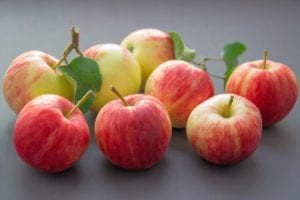Written by Joyce Smith, BS. This study found that quercetin and 3,5-dihydroxybenzoic acid (DHBA), two phytonutrients commonly found in apples, are pro-neurogenic, not only by activating precursor cell proliferation but also by promoting cell cycle exit, cellular survival, and neuronal differentiation.
 There may be some truth to the saying, ‘‘An apple a day keeps the doctor away.’’ Phytonutrients, such as flavonoids, are abundant in fruits and vegetables and by modulating molecular signaling pathways they can influence cognitive function 1.They are present in the brain at low concentrations; however, have been found to be highly effective in reversing age-related declines in memory due to their ability to interact with the cellular and molecular architecture of the brain. Resveratrol in grape skins and, in particular, epigallo-catechin-3-gallate (EGCG) in green tea are flavonoids that affect hippocampal neurogenesis 2. The process involved is known as brain plasticity ,where the neural networks in the brain can grow and reorganize in response to intrinsic or extrinsic stimuli to facilitate learning and memory.
There may be some truth to the saying, ‘‘An apple a day keeps the doctor away.’’ Phytonutrients, such as flavonoids, are abundant in fruits and vegetables and by modulating molecular signaling pathways they can influence cognitive function 1.They are present in the brain at low concentrations; however, have been found to be highly effective in reversing age-related declines in memory due to their ability to interact with the cellular and molecular architecture of the brain. Resveratrol in grape skins and, in particular, epigallo-catechin-3-gallate (EGCG) in green tea are flavonoids that affect hippocampal neurogenesis 2. The process involved is known as brain plasticity ,where the neural networks in the brain can grow and reorganize in response to intrinsic or extrinsic stimuli to facilitate learning and memory.
The research team of Ichwan and colleagues chose apples for the following study 3 because they are consumed worldwide and provide a generalized exposure across many cultures. The team’s two-pronged approach involved studying the cognitive benefits of quercetin, then extending their investigation to identify additional pro-neurogenic factors in the fruit.
Quercetin, the most abundant flavonoid in apple peel, is an antioxidant and a neuroprotectant of mitochondrial function 4. Although it affects neurogenesis through multiple pathways, Ichwan and team chose to study quercetin’s effects on stem cells. They found that, in vitro, laboratory-grown stem cells [neural precursor cells (NPCs)] from the brains of adult mouse generated more neurons and were protected from cell death when quercetin or hydroxybenzoic acid (DHBA) were added to the cultures.
The positive in vitro effects of quercetin were then confirmed in vivo by injecting quercetin intraperitoneally into test and control mice. Two weeks of high-dose quercetin treatment significantly increased stem cells and neurons, promoting survival and neuronal differentiation without affecting proliferation (P<0.001). High doses of DHBA treatment produced the same response – significant stem cell proliferation and neurogenesis – demonstrating that both flavonoids and DHBA are pro-neurogenic.
Given the above findings, Ichwan and team then investigated whether apple juice, apple peel or apple flesh had similar pro-neurogenic properties. DHBA is abundant in fruits, where it acts as a natural preservative 5. The team found that 3,5-DHBA not only increased stem cell proliferation and neurogenesis, but also increased their rate of maturation. While in vivo testing with apple juice supplementation did not effect neurogenesis, both the peel and flesh of apples were found to be pro-neurogenic when tested in vitro. Lastly, when researchers compared an apple cultivar (particularly rich in flavonoids) to six locally harvested varieties (Elstar, Pinova, Pilot, Rebella, Roter Berlepsch, and Jonagold apples), they found the absolute flavonoid content differed greatly among the varieties. Although all contained flavonoids in their peel, and to a much lesser extent in their flesh, the Pinova cultivar contained the greatest amount of flavonoids (almost 9 times greater than the other cultivars) and its peel and flesh had a similar higher pro-neurogenic quality.
In this study, 25 mM quercetin increased the survival and differentiation of adult hippocampal stem cells, both ex vivo and in vivo. The in vitro experiments used quercetin and DHBA as “targeting moieties to facilitate drug delivery across the blood brain barrier” 6 and although the in vivo experiments could not distinguish direct from indirect effects, the authors assume that the ex vivo studies implicate a direct delivery to the brain.
Source: Ichwan, Muhammad, Tara Walker, Zeina Nicola, Jutta Ludwig-Mueller, Christoph Boettcher, Rupert W. Overall, Vijay Adusumilli et al. “Apple peel and flesh contain pro-neurogenic compounds.” bioRxiv (2020).
© 2021 The Authors. This is an open access article under the CC BY-NC-ND license (http://creativecommons.org/licenses/by-nc-nd/4.0/)
Click here to read the full text study.
Posted March 23, 2021.
Joyce Smith, BS, is a degreed laboratory technologist. She received her bachelor of arts with a major in Chemistry and a minor in Biology from the University of Saskatchewan and her internship through the University of Saskatchewan College of Medicine and the Royal University Hospital in Saskatoon, Saskatchewan. She currently resides in Bloomingdale, IL.
References:
- Spencer JP. The impact of flavonoids on memory: physiological and molecular considerations. Chemical Society reviews. 2009;38(4):1152-1161.
- Ortiz-López L, Márquez-Valadez B, Gómez-Sánchez A, et al. Green tea compound epigallo-catechin-3-gallate (EGCG) increases neuronal survival in adult hippocampal neurogenesis in vivo and in vitro. Neuroscience. 2016;322:208-220.
- Ichwan M, Walker TL, Nicola Z, et al. Apple Peel and Flesh Contain Pro-neurogenic Compounds. Stem cell reports. 2021;16(3):548-565.
- Nichols M, Zhang J, Polster BM, et al. Synergistic neuroprotection by epicatechin and quercetin: Activation of convergent mitochondrial signaling pathways. Neuroscience. 2015;308:75-94.
- Soni MG, Carabin IG, Burdock GA. Safety assessment of esters of p-hydroxybenzoic acid (parabens). Food and chemical toxicology : an international journal published for the British Industrial Biological Research Association. 2005;43(7):985-1015.
- Guo H, Wang R, Wang D, et al. Deliver anti-PD-L1 into brain by p-hydroxybenzoic acid to enhance immunotherapeutic effect for glioblastoma. Journal of controlled release : official journal of the Controlled Release Society. 2020;320:63-72.
